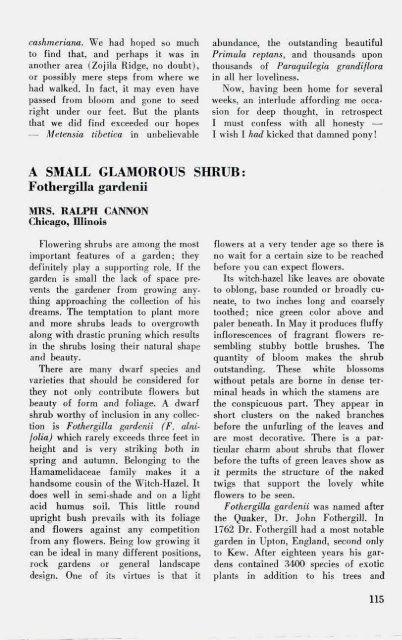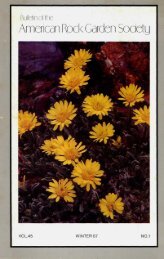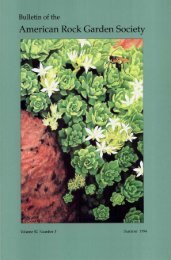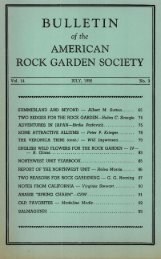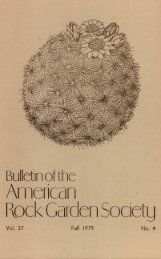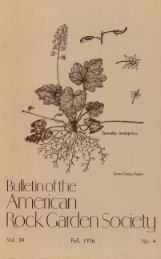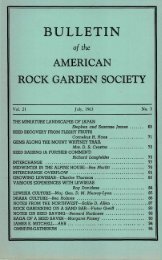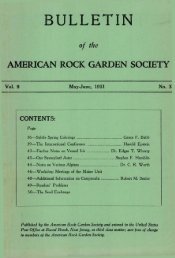Bulletin - Summer 1979 - North American Rock Garden Society
Bulletin - Summer 1979 - North American Rock Garden Society
Bulletin - Summer 1979 - North American Rock Garden Society
Create successful ePaper yourself
Turn your PDF publications into a flip-book with our unique Google optimized e-Paper software.
cashmeriana. We had hoped so muchto find that, and perhaps it was inanother area (Zojila Ridge, no doubt),or possibly mere steps from where wehad walked. In fact, it may even havepassed from bloom and gone to seedright under our feet. But the plantsthat we did find exceeded our hopes— Metensia tibetica in unbelievableabundance, the outstanding beautifulPrimula replans, and thousands uponthousands of Paraquilegia grandiflorain all her loveliness.Now, having been home for severalweeks, an interlude affording me occasionfor deep thought, in retrospectI must confess with all honesty —•I wish I had kicked that damned pony!A SMALL GLAMOROUS SHRUB:Fothergilla gardeniiMRS. RALPH CANNONChicago, DlinoisFlowering shrubs are among the mostimportant features of a garden; theydefinitely play a supporting role. If thegarden is small the lack of space preventsthe gardener from growing anythingapproaching the collection of hisdreams. The temptation to plant moreand more shrubs leads to overgrowthalong with drastic pruning which resultsin the shrubs losing their natural shapeand beauty.There are many dwarf species andvarieties that should be considered forthey not only contribute flowers butbeauty of form and foliage. A dwarfshrub worthy of inclusion in any collectionis Fothergilla gardenii (F. alnijolia)which rarely exceeds three feet inheight and is very striking both inspring and autumn. Belonging to theHamamelidaceae family makes it ahandsome cousin of the Witch-Hazel. Itdoes well in semi-shade and on a lightacid humus soil. This little roundupright bush prevails with its foliageand flowers against any competitionfrom any flowers. Being low growing itcan be ideal in many different positions,rock gardens or general landscapedesign. One of its virtues is that itflowers at a very tender age so there isno wait for a certain size to be reachedbefore you can expect flowers.Its witch-hazel like leaves are obovateto oblong, base rounded or broadly cuneate,to two inches long and coarselytoothed; nice green color above andpaler beneath. In May it produces fluffyinflorescences of fragrant flowers resemblingstubby bottle brushes. Thequantity of bloom makes the shruboutstanding. These white blossomswithout petals are borne in dense terminalheads in which the stamens arethe conspicuous part. They appear inshort clusters on the naked branchesbefore the unfurling of the leaves andare most decorative. There is a particularcharm about shrubs that flowerbefore the tufts of green leaves show asit permits the structure of the nakedtwigs that support the lovely whiteflowers to be seen.Fothergilla gardenii was named afterthe Quaker, Dr. John Fothergill. In1762 Dr. Fothergill had a most notablegarden in Upton, England, second onlyto Kew. After eighteen years his gardenscontained 3400 species of exoticplants in addition to his trees and115


